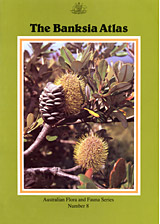The Banksia Atlas


The Banksia Atlas is an
History
The Banksia Atlas project was modelled on the
Funded by the ABRS and the
As a result of The Banksia Atlas project, two new species, B. epica and B. oligantha (Wagin Banksia), were discovered in Western Australia, new varieties of B. oblongifolia (Fern-leaved Banksia), B. occidentalis (Red Swamp Banksia), B. seminuda (River Banksia) and B. spinulosa (Hairpin Banksia) were recognised, and a cultivar of B. serrata (Saw Banksia), Banksia 'Superman', was registered. A number of hybrids were recorded for the first time, and some rare flower colour variants were noted. Knowledge of distribution was increased for virtually every species, with the range extended to significant new locations for around 40 species. Previously unknown populations were discovered for a number of rare Banksia species, adding to the knowledge of the conservation status of these species. For example, B. chamaephyton (Fishbone Banksia) was struck off the list of declared rare plants as a result of knowledge gained during The Banksia Atlas project.
Edited by Anne Taylor and Stephen Hopper and published by the Australian Government Publishing Service, The Banksia Atlas was first published in 1988 [3] and reprinted with amendments in 1991.[4] It presents distribution information for 75 species, 1 subspecies and 14 varieties of Banksia. For each taxon the Atlas provides an illustration and brief discussion. A distribution map is provided, along with a breakdown of observation data showing population sizes, growth forms, habitat types, response to fire, flowering times, and observed pollinators.
Notes
- ISBN 978-0-7309-0329-1
- ^ Banksia atlas : field notebook, [Dept. of Fisheries & Wildlife?], 1987, retrieved 14 December 2015
- ISBN 978-0-644-07124-6
- ISBN 978-0-644-07124-6
References
- Taylor, Anne; ISBN 0-644-07124-9.
